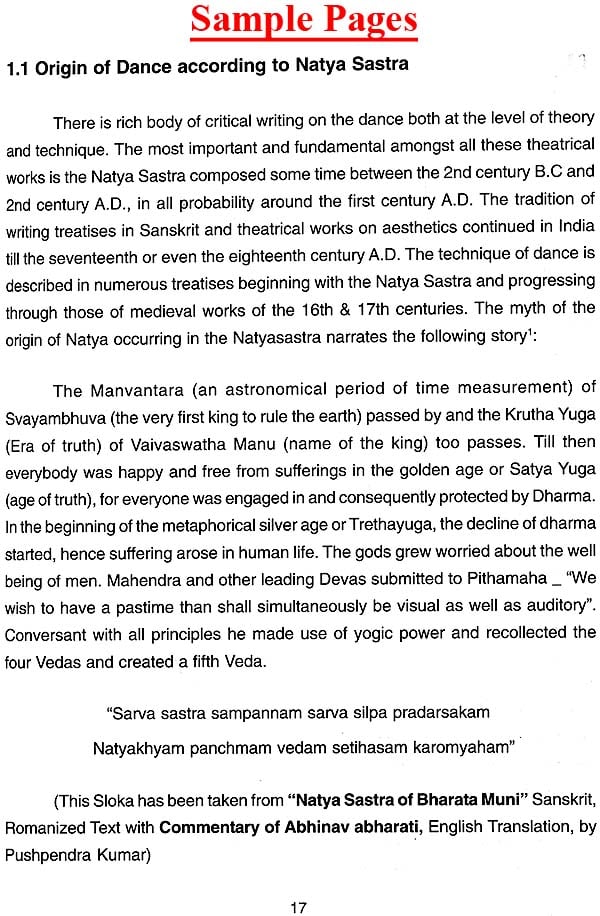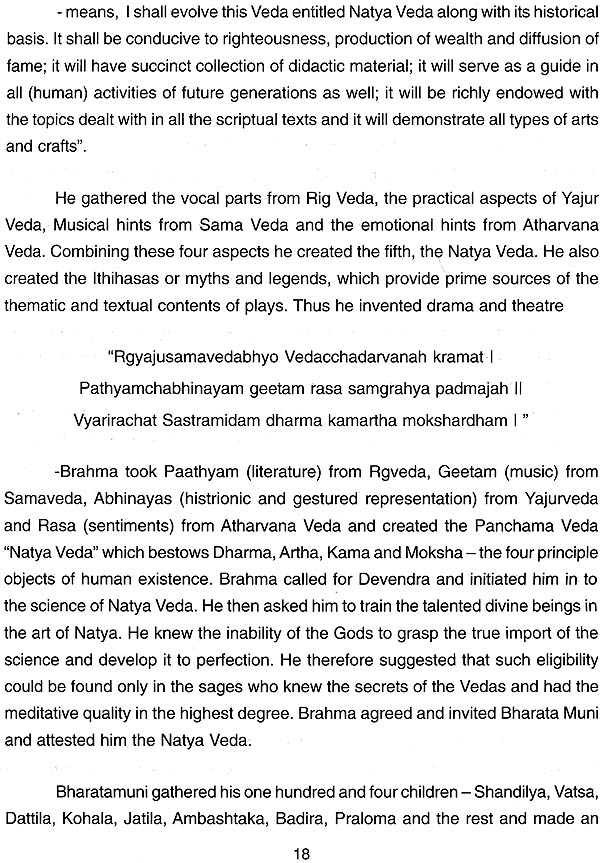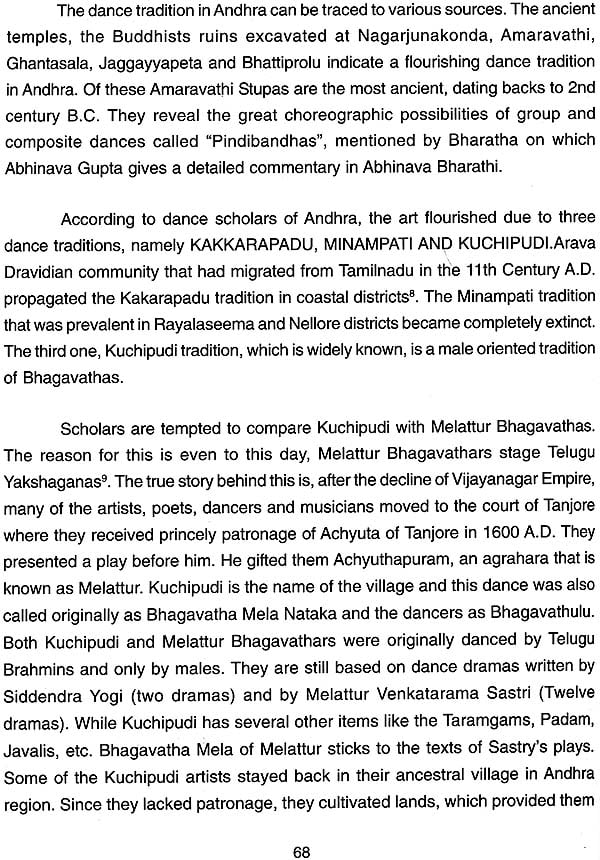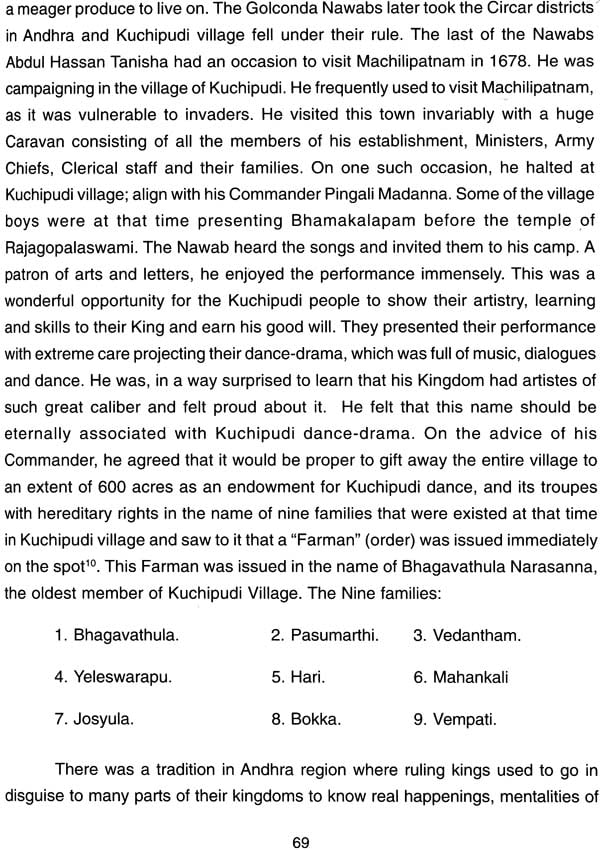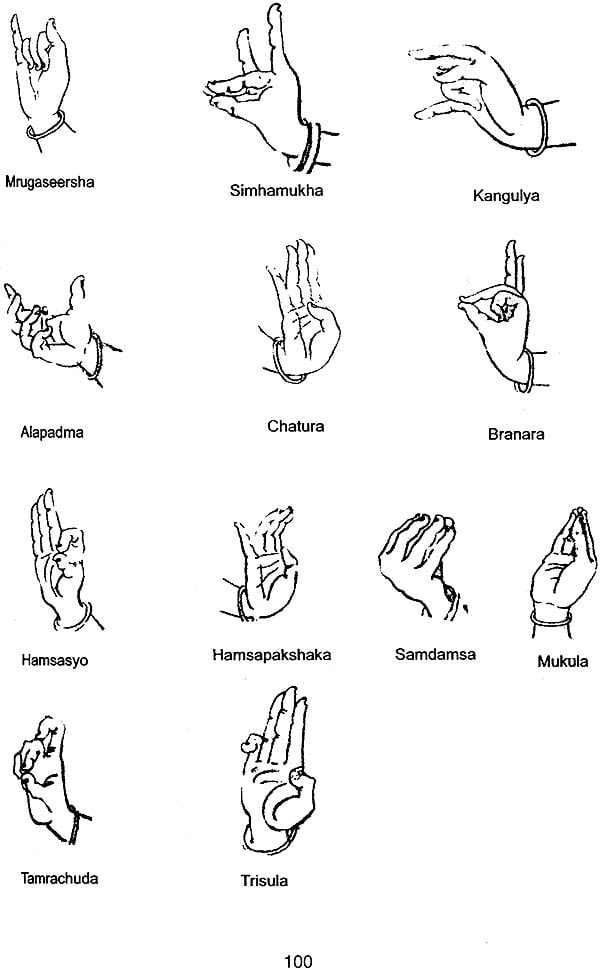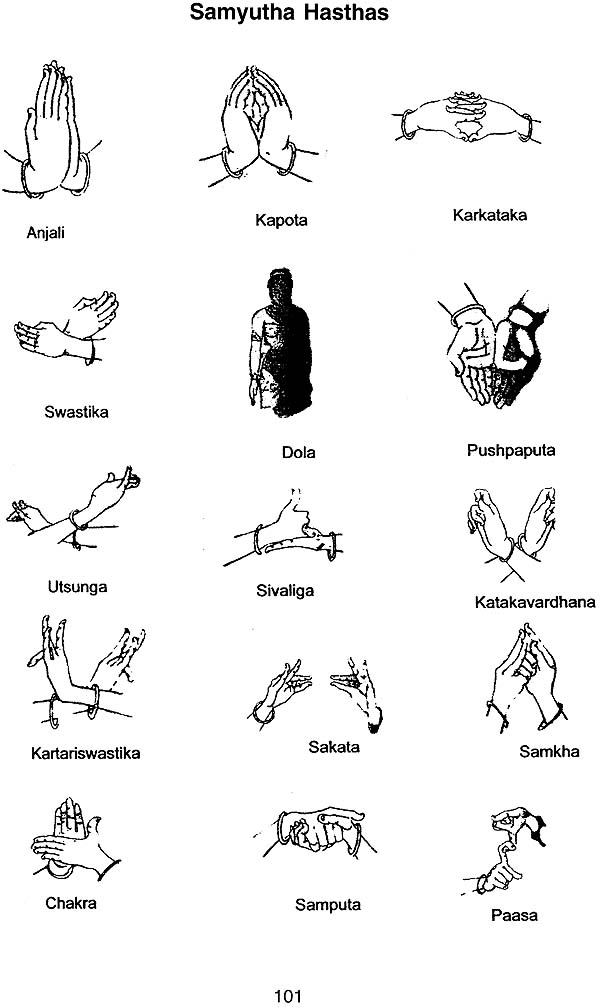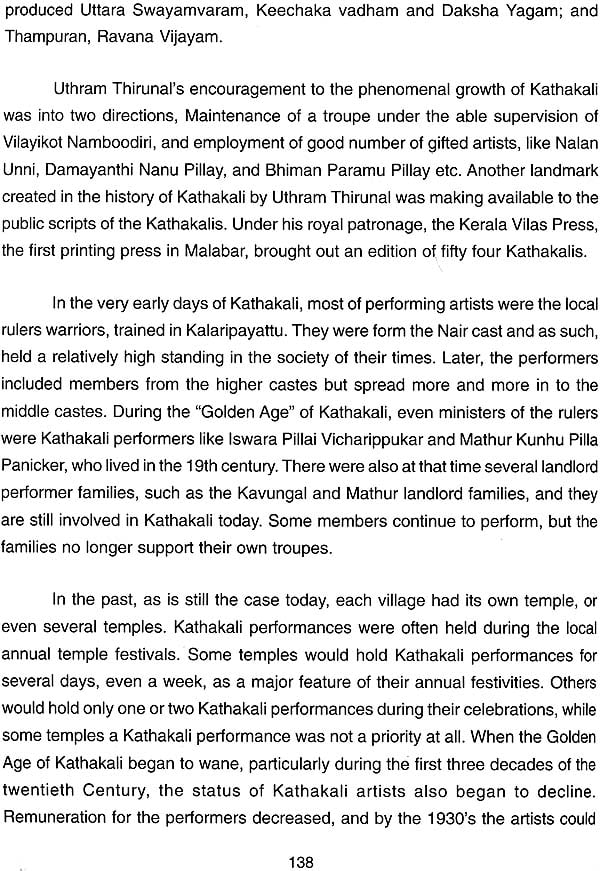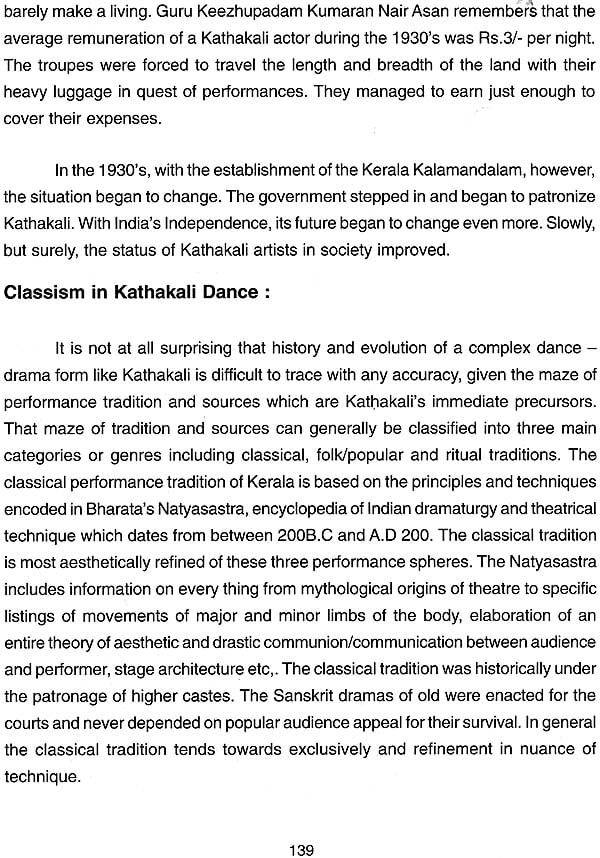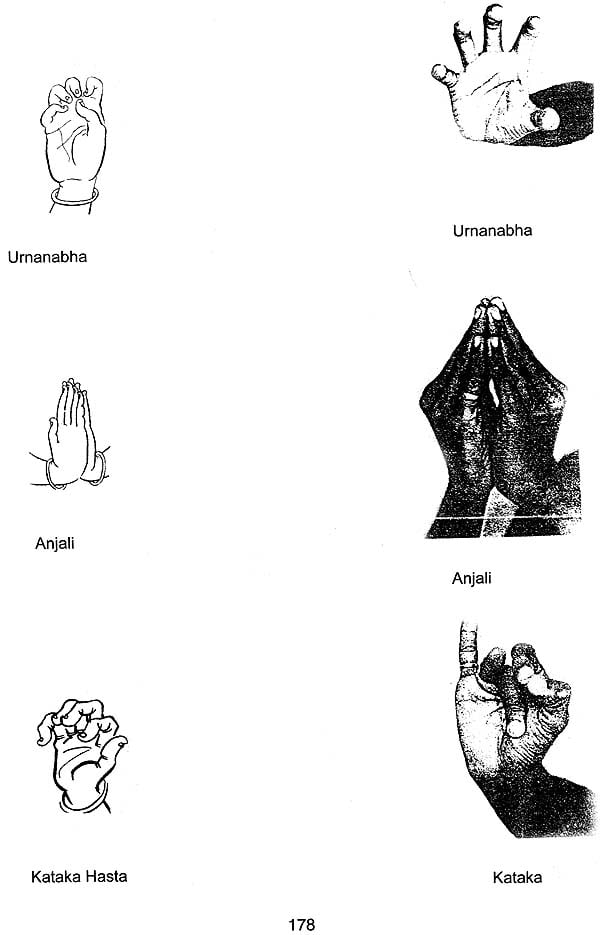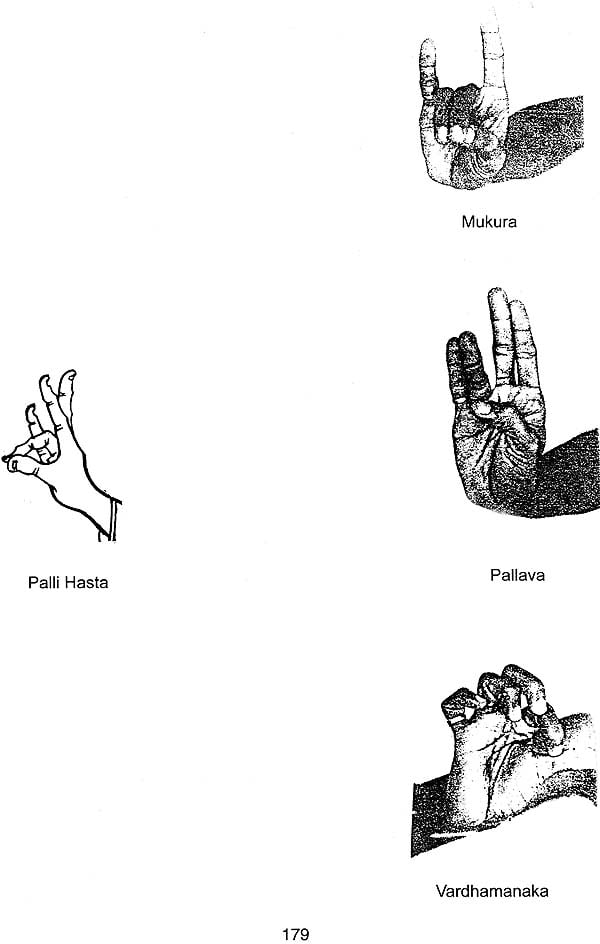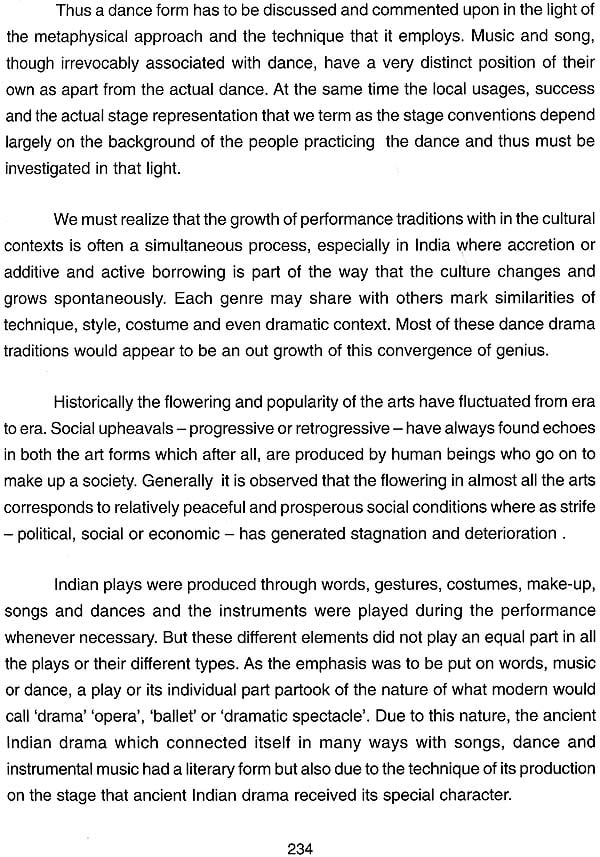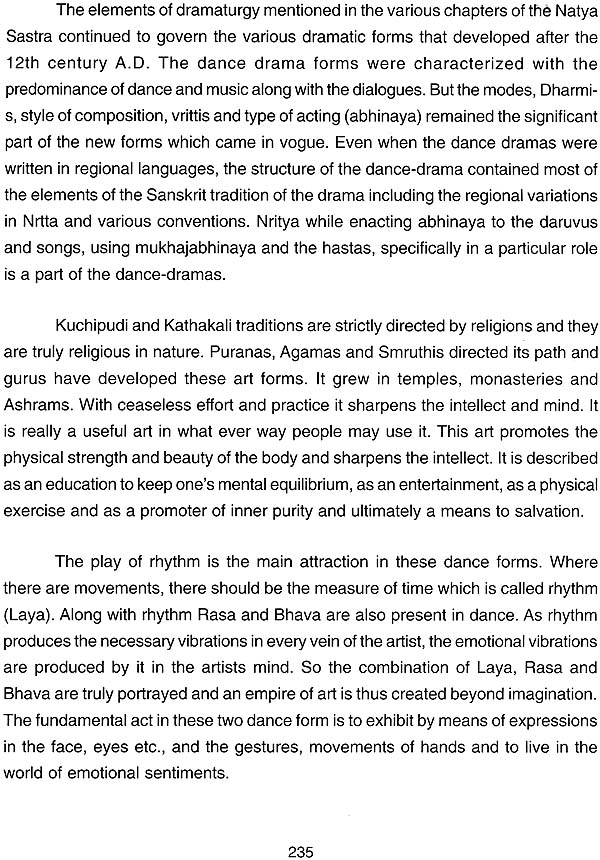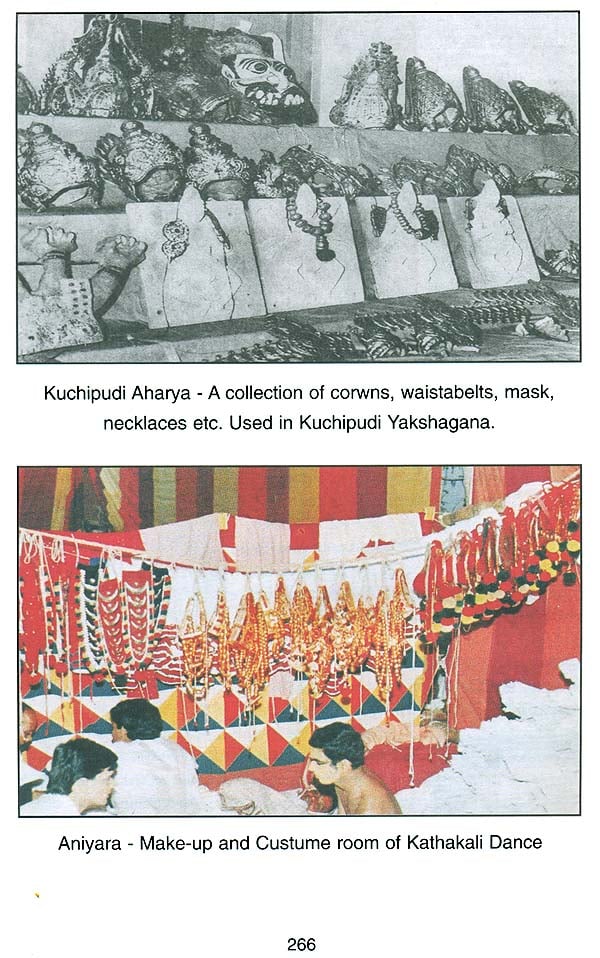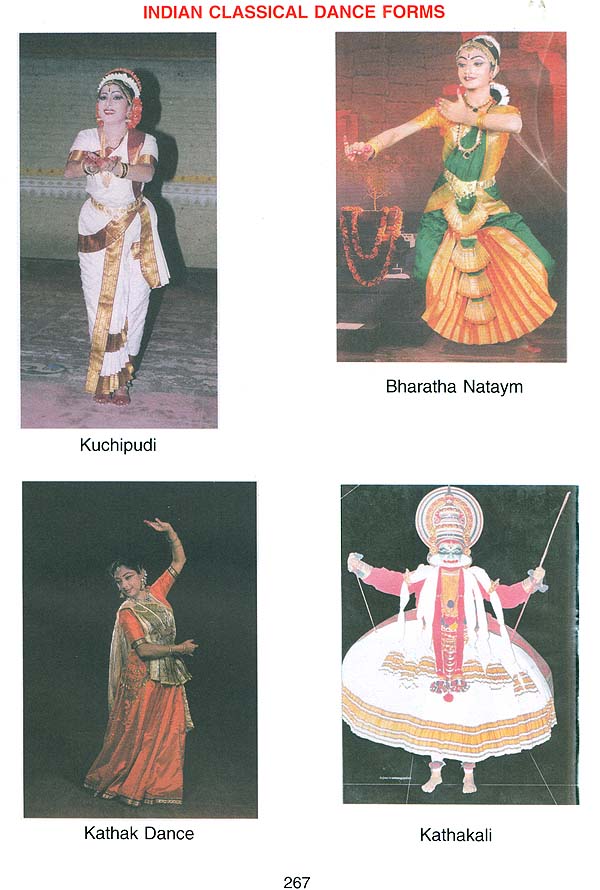
Comparative Study of Chaturvidha Abhinayas Between Kathakali and Kuchipudi Yakshagana (Comprehensive Analysis of Four Kinds of Expressions in Kathakali and Kuchipudi Dance, Drama Traditions)
Book Specification
| Item Code: | NAN121 |
| Author: | Dr. P. Rama Devi |
| Publisher: | Patinjarayil Publications |
| Language: | English |
| Edition: | 2013 |
| Pages: | 286 (37 Color and 147 B/W Illustrations) |
| Cover: | Hardcover |
| Other Details | 9.5 inch X 7.5 inch |
| Weight | 740 gm |
Book Description
"Kuchipudi" is the name of a village in Krishna District of Andhra Pradesh. It was a male oriented Natya mela tradition belonging to Bhagavatha mela for a long time and only dance dramas of Mythological themes were performed. Siddendra Yogi, who niched a definite format for this dance form, has been considered as father of Kuchipudi dance tradition.Kuchipudi artists use to perform Veedhi Natakas, Kalapas, Yakshaganas and Dance Dramas in which Natya and abhinaya were dominantly featured. Consequently a solo Kuchipudi repertoire was shaped combining some extracts from the existing dance- dramas and also adding some special choreographed items like Taramgams, Sabdam, Keerthanas, Padams, Astapadis and Javalis etc,. Vedantham Laxmi Narayana Sastri (1880-1940) is the first person to introduce this solo system in Kuchipudi dance Tradition.
Kathakali is an art form from Kerala which has evolved from many social and religious theatrical forms (which existed in the southern region in ancient time). Kathakali is blend of dance, music and acting, dramatizes the stories which are mostly adopted from Indian epics. The dancer expresses himself through codified hasta madras and facial expressions, closely following the verses (Padam) that are sung. Kathakali derives its textual sanction the Balarama Bharatham. Chakiar Kooth, Koodiattam, Krishnattam and Rama- nattam are few of the ritual performing arts of Kerala which have had a direct influence on Kathakali form and technique. In the traditional style Kathakali performances were conducted in the open spacious compounds of temples. A large oil lamp is placed in front of stage and two people hold a curtain called "Tirassela". Kathakali is visual art where Aharya- costumes and makeup suits the character as per the tents laid down in "Natyasastra". The characters in a Kathakali performance are broadly divided in to "Satvika", "Rajasika" and "Tamasika" types.
"Comparative study of Chaturvidha Abhinaya between Kathakali and Kuchipudi Yakshagana", a reach work by Dr. P. Rama Devi, with specialization on Chaturvidha Abhinaya and its comparision with the traditional Kathakali is a excellent contribution for the great art forms of Kuchipudi and Kathakali Dances. I have tried to appraise the theme of the book in the following lines .....
Art is a universal language. Each civilization has its own mode of expression, architecture and art. Each culture is different but each makes an important contribution to the great and ever widening world of civilization. Indian dance being a supreme art, its scope as explained by Sage Bharata embraces all themes in life which it vividly portrays. There is no theme possible in dance which can't be interpreted in the codified language of "Natya". Similarly, dance has a message for the audience.
India has a rich heritage and high regional culture, there developed many styles of dances. Each style has got its special and attractive features. Common to these styles are certain aesthetic principles, similar technical features and mythological backgrounds. India is divided in to many states with multiple languages, regional traditions, customs and culture. This may be one of the reasons for having nine classical dance forms in India- Bharatanatyam, Kuchipudi, Kathakali, Kathak, Odissi, Mohiniattam, Manipuri, Sattriya and Chau. Kuchipudi dance was originally a dance drama tradition dating from 14th century when the Devadasi tradition was dying this dance form emerged as "Bhagavata Mela Nataka" in Natya technique. Its birth place was Kuchipudi village in Krishna district in Andhra Pradesh. Sidhendra Yogi, the father of Kuchipudi Dance traditon, conceived Parijatapaharanam which also known as "Bhamakalapam" and taught to the young boys of the village. Later Kalapas Kuchipudi artists started performing Yakshaganas and dramas. There was Nritya, Nritta and Natya in these dance dramas with a traditional mythological theme. Both Sringara or Bhakti or Veera or Sthayi rasas and other Rasas in Sanchari rasas as mentioned in Natya Shasrta to suit the moods, whims and Lokadharmi were well blended in these dramas, thus creating interest and enthusiasm in the mind of a layperson. Besides it used to be a feast to the scholars as Kuchipudi dance dramas were strictly based on Natya Shastra. The dancers sing and deliver speeches while portraying characters. Male actors portraying female roles singing . ~with the modulation to suit the character was generally a difficult task. This striking feature we can see in Kuchipudi Yakshagana as the ladies were not allowed to participate in these dance dramas. The lyrics were usually in simple telugu and Sanskrit. Costumes, which were conventional, were specially designed and carried significance. Kuchipudi artists strictly follow Bharatas Natya Shastra for Natya aspect and Nandikeshwara's Abhinayadarpanam for Angikabhinaya mostly used for Nritya aspect, nicely blending the Natyadharmi and Lokadharmi and thus giving a fine shape to their art which was equally appreciated by scholars and common people.
Kathakali, which is the stylized art form of Kerala is also a blend of dance and drama. They enact the stories which are adopted from the Indian epics. It is an art which has evolved from many social and religious theatrical forms which existed in the southern regions in ancient times. Chakiarkooth, Koodiyattam , Krishnattam and Ramanattam are few of the ritual performing arts of kerala which have had a direct influence on Kathakali in its form and technique. The dancer expresses himself through codified hand gestures and facial expression closely following the verses that are sung. Kathakali delivers its textual sanction from Balarama Bharatam and "Hastalakshanadeepika". The stories are selected from the epics which are written in a highly sanskritised verse of Malayalam. Kathakali is visual treat as its costumes and makeup are bright, colorful and attractive which suits the character. Kathakali dance is chiefly interpretative. The characters in a kathakali performance are broadly divided in to "Satvika", "Rajasika" and ''Tamasika'' types. The technical details cover every part of the body from facial muscle to fingers, eyes, hands and wrists. The facial muscles play an important role. The movements of eyebrows, eyeballs and lower eyelids as described in Natyashastra are not used to such an extent in any other dance style like it is used in kathakali.
This contribution of Dr. P. Rama Devi shows a scholarly exposition of every aspect of these both classical dance forms - Kathakali and Kuchipudi Yakshagana and is an extraordinary work of comparision of the chathurvidha Abhinayas (the Four types of expression) in these two dance dramas. The unique features of the book lie in the discussion and analysis of gestures, talas, and abhinays of both forms. Hence this book has not only theoritical utility but also practical utility for both forms as well as for art lovers and researches in this field.
About the Author
- Dr. P. Rama Devi Established Sri Sai Nataraja Academy of Kuchipudi Dance in 1989 in Marredpally, Secunderabad and since then she has strived to create many budding artists in every sense of the world, for the coming generations.
- Dr. Rama Devi has done Ph.D. M. Phil, M.A. , B.Sc., B. Ed. Diploma in Software Engineering, Praveena in Hindi, and Diploma in Home Science to her credits. She is a graded artist from Doordarshan.
- Dr. Rama Devi is not only a Guru, But also Performer, Choreographer, author, Scholar, Writer and Organizer.
- She authored so far 5 books on Kuchipudi Dance namely "Kuchipudi Dance in Textual Form", "Kuchipudi Kalapas an Odyssey Rediscovered", Kuchipudi Natyam-certificate", "Kuchipudi Natyam-Diploma", and "Histrionic Expressions in Kuchipudi Dance". These books are the syllabus books for Certificate & Diploma courses offered by P.S.Telugu University and are recognized by Raja Rammohan Roy Library, Calcutta. As a writer she scripted 4 Dance ballets in Telu u & 5 keerthanas and few Slokas.
- She has performed at various prestigious platforms all over the country like Ujjain Festivals, SurajKundh Festivals, Sanskrit Ballet Festivals, IInd International Budha Festivals, Deccan festivals, Alampur Festivals, Soorya festival & also performed in USA. She has not confined herself to just female roles but has demonstrated outstanding potential in performing strong and masculine characters of the valiant Ravana, callous Mahishi, and other mythological characters like Krishna, Rama, Shiva, etc.,
- She was one among the panel of members in the JURY OF A.P. TV & FILM NANDI AWARDS FOR THE YEAR 2011, JUDGE IN THE SELECTION OF SENIOR SCHOLARSHIP SCHEME OF CENTRAL GOVERNMENT IN THE FIELD OF KUCHIPUDI DANCE and also JUDGE IN THE SELECTION FOR JUNIOR SCHOLARSHIP SCHEME OF CENTER FOR CULTURAL RESOURSES & TRAINING (CCRT) NEW DELHI,CHIEF CO-COORDINATOR FOR KERALA SANGEET NATAK ACADEMY ADHOC COMMITTEE, EXPERT COMMITTEE MEMBER FOR EVALUATING M.Phil THESIS CONDUCTED BY P.S.TELUGU UNIVERSITY, MEMBER, ACADEMIC ADVISORY COMMITTEE, UNIVERSITY OF SILICON ANDHRA, CALIFORNIA, USA.
- She has presented Papers on various topics in many Seminars, Conducted Workshops & gave lecture demonstrations in conferences & festivals, colleges & various organization in A.P, KARNATAKA, KERALA & U.S.
- Choreographing ballets with precise rhythmic patterns and expression is not an easy task for every dancer. Dr. P Rama Devi with this infallible ability has choreographed 25 ballets and more than 50 solo items and has won applause.
- She has written many articles on various topics of dance in Telugu and English for various leading magazines & Souvenirs. Her knowledge in software technology helped her to make her ideas of presenting various topics in dance made it more effective and attractive by using the modern technology. She presented Golla Kalapam by using the power point technology to show the Pindothpathy part of Golla Kalapam (a traditional dance drama of Kuchipudi dance repertoire) with the embryology in science. Recently She has conceived a CD titled "NATYA SASTRA IN A NUTSHELL", which covers various topics of Natya Satra that enhance the performance & choreography skills of an artist/dancer. This DVD is very useful to all Indian Classical Dancers as its lucid language, pictures and videos make the artists to understand easily.
- She is recipient of KERALA STATE SANGEET NATAK ACADEMY'S KALASREE AWARD, senior fellowship from H.R.D, Ministry of Culture, New Delhi. Navarasa Natya Prapurna, Badam Sarojinidevi Award, Pancha Ratna Mahila Puraskaram, Lifetime achievement award, Naatya Kalpa Dhruma , Nrtha Vilasini , Durgabai Deshmukh Award etc ....
Indeed it was a pleasure to go through Dr.P.Rama Devi's thesis "COMPARATIVE STUDY OF CHATHURVIDHA ABHINAYAS BETWEEN KATHAKALI AND KUCHIPUDI YAKSHAGANA", which she is going to release in a book form. Years of dedication and hard work can only bring out such valuable thesis. To compare and analyze the four expressions of the great Indian Classical Dance forms like Kathakali and Kuchipudi is not a very easy task. It needs in depth knowledge of both practical & theoretical aspects of dance. Our Indian classical dances are traditional and religious in nature. I could see a comprehensive analysis of Angika, Vachika, Aharya and Satvikabhinayas between these two dance forms in this work. This thesis shows her sincere and keen observation for even in minute aspects of these two dance drama traditions. It's a perfect thesis with relevant topics and its perfect execution. Research should throw light on the topics and should be a torch light for the future scholars to do further research in that topic. This is such a commendable thesis which has been written keeping all these points in mind. I appreciate Dr.P.Rama Devi for publishing such informative book and indeed it will be useful for all dancers and art lovers. I wish her all success and good luck in all her future endeavor.
A Value addition to Kuchipudi Yakshagana
Like the Vaggeyakaras, there are a few Dancers who can compose and dance. Dr. P. Ramadevi, joined the list of such rare personalities. While presenting the panoramic view of Indian Classical dances in her book, she has highlighted the techniques and expressions in Bhagavatamela Natyam and Yakshagana. Focusing upon the similarities and variations in Kathakali and Kuchipudi styles of Dance, she has successfully endeavored in her explanation with reference to Chaturvidha Abhinaya viz; Angikavainaya Aharyabhinaya, Vachikabninaya and Satvikabhinaya which testifies that Dr .. Ramadevi excels in both the dance forms not only in theory but also in practice.
Dr. Ramadevi's presentation on the contribution of the Kuchipudi Trio in this book which attests her sound knailadge on the 'dance 'and its exponents who strived hard for the' revival and sustenance of Kuchipudi Dance along with the exponents of Kathakali Dance.
Unlike the other scholars, Dr. Ramadevi took-up a comparative Study which is very much useful to the students of Dance in general and Kathakali and Kuchipudi in particular. I take this opportunity to congratulate her for undertaking an interesting research topic and also for bringing out a book useful for the many. Hope she brings out such books in the near future on new and such neglected topics in Dance. I feel that this work adds value to the corpus of books on Dance forms of South lndia.
Culture is a thought, connected with places, periods and persons in all shades of existing life. It is all together a refined artistic behavior of human beings in the society. Culture explains the refined behavior, deep knowledge, a great appreciation of beautiful things in nature. Culture denotes the people's life, their language, mode of living aims and aspirations, habits and practices, dress and ornaments, faith and believes. It differs from people to people. While the culture reflects the habit, language etc., of the region, the art also is born out of the same cultural life of the people. An artist can pass on to the world a different out look of the culture and through it he can explain the purpose for living. As a complete system, different art forms in many facets, with regional back grounds represent the culture. All regional cultures combined and form a National Heritage Reflecting the humanity in different shades and moods with separate characters and identity, they look different from each other.
India has always been the melting pot of different cultures of the races that periodically swept down her fertile planes and made their in permanent home. To lay down tenets that would be acceptable to the temperaments, believes and inclinations of all these ethnical groups was a Herculean task. A way had to be found which was envelopment of the multi racial society and at the same time it so very simple as to be acceptable to the ordinary simple mind. To define a way of life that was beautiful, we develop a tendency to give a background, a foundation that is divine to everything of beauty. Beauty should be retained and preserved intact and inviolate, to be passed on from generation to generation for each and every era to appreciate it and worship it. It is this trait that has enabled that great Indian or rather the Hindu culture to endure the onslaught of time and the generations of invasions. But all these invasions were absorbed in the main stream of Hindu tradition as minor tributaries causing uneventful ripples.
It is an embodiment of the mythological, historical, sociological and cultural heritage. If we observe the tradition, its message is not only righteousness (Dharma) and morality (Neethi) but also it stands as the memorial and voice which reflects all that is great in our ancient culture beyond the reach of words. If we look at this art which has a very wide range and depth like an ocean, in a personal point of view, it is a mile stone in the path of worship.
Life in itself is a composition of arts, peculiar to its own measures. Every human action, as that of an animal, has a direct command of the soul and that action itself is "dance". Of all the arts, the art of dancing first expresses itself in human person. Music, acting, poetry form a single compartment of human personification, while sculpture painting and all other arts of design proceed in another stream. There is no primary art beyond these two arts, and their origin is much earlier than man himself and dancing came first. Dance is the source for eternal bliss, consciousness and the treasure of physical and spiritual knowledge. It gives entertainment and pleasure for varied sections of people according to their comprehending and understanding ability whether they may be scholars or ignorant ones, great or small, rich or poor.
Tracing the history of the origin of the dancing in the human person, it is seem intimately entangled with the human behavior in respect of the tradition of war, labor, entertainment, education, whereas some of the wisest philosophers and the ancient civilization have considered the dance as "the pattern in accordance with which the moral life of men must be woven"
Art has several meaning such as "an attraction", "a light", "a sign", and "knowledge". But practically it means "to direct" or "a direction". That is the reason for calling dance, dramas, Yakshagana etc., as fine arts or Lalithakalas. All these meanings and ideas are inherent in this Natyakala. Hence it is great. It is an art of practice, in the academic sense; it is a medium of teaching. Historically, the five greater fine arts were painting, sculpture, architecture, music, poetry, drama and dance. Today, the fine arts commonly include visual and performing art forms, such as painting, sculpture, installation, Calligraphy, music, dance, theare, architecture, photography and printmaking.
Minute, sensitive, subtle and graceful movements, along with Bhava, Rasa and Tala, give a meaningful, particular, perfect aesthetic shape to the literature and it is known as "dance" or "Natya". If we understand life's experiences with the artistic point of view, all the movements and jumps would become the art of dance, endowed with Rasa and Bhava. If the same emotional, sentimental feelings take the form of sound and rhythm it becomes music. If they are formulated in words it becomes literature. While it blossoms in visualized form it is called "DRAMA".
The art of Natya is but an expression of the natural instincts in human beings to feed the soul with well trained mind and intellect inhabiting and well kept body. Natya is generally linked with healthy Puranic stories, which conveys the spiritual culture in very enjoyable manner. A well performed dance recital is nothing less than a "JNANA YAGNA". It is the worship of the supreme through the medium of Mother Nature. Natya yields the effects of "Dharma" to those who follow the path of "Dharma", fulfillment of desire those who follow the path of "Kama", "Aatmananda" to those who wish for it, secrets of creation to the Lovers of art, the eminence of Tala and Laya to the sympathetic audience; totally it is a great joy.
When sense objects and concepts reflect in the nervous system through sense organs, the heart begins to throb with feelings as if by magnetic vibrations and vocalization. It is with the embracing sounds, we call "Omkara". That creates the springs of joy, emotions, rhythmic beats and the sound of music all this is the life of dance Shiva, as the cosmic Dancer, represents both creation and destruction. The right hand holds the drum: for, nada or sound was the first element in the universe from which flowed all languages, music and literature. The hand of the half-moon holds a tongue of flame, symbol of destruction, the burning away of all evil. The lower right hand held in a gesture of tender solicitude held in front of the It is an embodiment of the mythological, historical, sociological and cultural heritage. If we observe the tradition, its message is not only righteousness (Dharma) and morality (Neethi) but also it stands as the memorial and voice which reflects all that is great in our ancient culture beyond the reach of words. If we look at this art which has a very wide range and depth like an ocean, in a personal point of view, it is a mile stone in the path of worship.
Life in itself is a composition of arts, peculiar to its own measures. Every human action, as that of an animal, has a direct command of the soul and that action itself is "dance". Of all the arts, the art of dancing first expresses itself in human person. Music, acting, poetry form a single compartment of human personification, while sculpture painting and all other arts of design proceed in another stream. There is no primary art beyond these two arts, and their origin is much earlier than man himself and dancing came first. Dance is the source for eternal bliss, consciousness and the treasure of physical and spiritual knowledge. It gives entertainment and pleasure for varied sections of people according to their comprehending and understanding ability whether they may be scholars or ignorant ones, great or small, rich or poor.
Tracing the history of the origin of the dancing in the human person, it is seem intimately entangled with the human behavior in respect of the tradition of war, labor, entertainment, education, whereas some of the wisest philosophers and the ancient civilization have considered the dance as ''the pattern in accordance with which the moral life of men must be woven"
Contents
| Introduction | 41640 | |
| Chapter One | Teaching & Expressions in Indian classical Dances Origin of Dance According to Natya Sastra | 17-20 |
| History of Dance | 21-32 | |
| Contribution of Natya Sastra to the Diaspora of Indian Dances | 33-34 | |
| The Significant Classical Dance Forms of India | 35-49 | |
| Bhagavatha mela natakam | 50-52 | |
| Yakshagana | 53-62 | |
| Chapter Two | Kuchipudi Dance-Its origin & Development | 65-71 |
| Kuchipudi Bhagavatha Mela Natak | 72-74 | |
| The Structure and Contents of Kuchipudi Yakshagana | 75-80 | |
| Kuchipudi Kalapas | 81-86 | |
| Bhama Kalapam | 87-88 | |
| Golla Kalapam | 89-94 | |
| Sailent features of Kuchipudi Yaksha Ganas | 95-97 | |
| Angikabhinaya | 98-103 | |
| Aaharyabhinaya | 104-105 | |
| Important Characters & Their Aharya in Kuchipudi yaksha Gana | 106-111 | |
| Vachikabhinaya | 112 | |
| Satvikabhinaya | 113 | |
| Chapter Three | Kathakali Dance -Its Origin & Development | 123-124 |
| Evolution of Kathakali | 125-128 | |
| Development of Kathakali | 129-138 | |
| Classism in Kathakali | 139 | |
| Angikabhinaya | 140-146 | |
| Aaharyabhinaya | 147-152 | |
| Vachikabhinaya | 152-154 | |
| Satvikabhinaya | 155-156 | |
| Performance Sequence | 156-160 | |
| Chapter Four | Comparative Study of Kuchipudi and Kathakali Dance Traditions with special reference to Chaturvidhabhinaya | 163-164 |
| Angikabhinaya | 165 | |
| Single Hand Gesures | 166-179 | |
| Bhandavya Hastas | 180 | |
| Devatha hastas | 181 | |
| Dikpalaka Hastas | 182 | |
| Navagraha & Other Hands | 183 | |
| Talas in Kathakali & Kuchipudi | 184-186 | |
| Aaharyabhinaya | 187-189 | |
| Vachikabhinaya | 189-196 | |
| Satvikabhinaya | 196-208 | |
| Chapter Five | Kunchipudi & Kathakali Dance Forms today Innovations & Changes in Kathakali Dance | 211 |
| Innovations & changes in Kuchipudi Dance | 212-214 | |
| Eminent Exponents of Kuchipudi Dance & their contribution | 215-218 | |
| Eminent Exponents of Kathakali Dance & Their Contribution | 218-219 | |
| Questioner & Interviews | 219-224 | |
| Individual Research Works/ Field Work of the present researcher | 225-230 | |
| Conclusion | 230-238 | |
| Bibliography | ||
| Annexture | ||
| a | Rare photographs of Eminent/International fame artists of Kuchipudi and Kathakali | |
| b | Field study of the Scholar (Ballets Schoreographed, interviews & talks) |
